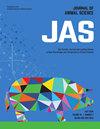Inbreeding depression for litter size in two mice lines under divergent selection for environmental birth weight variability using genomic data
IF 2.9
2区 农林科学
Q1 AGRICULTURE, DAIRY & ANIMAL SCIENCE
引用次数: 0
Abstract
Inbreeding depression (ID) is usually observed as reduced survival and fertility and may have a variable impact in different populations. The aim of this study was to estimate ID from genomic and pedigree data in the litter size (LS) of the high variability line (H-Line) and the low variability line (L-Line). Of these, the L-Line performed better on traits related to robustness. A total of 1587 females from 26 selection generations were genotyped with a high-density SNP array. LS data of 732 L-Line and 648 of H-Line animals were used. The following were calculated: pedigree inbreeding coefficient (FPED), genomic inbreeding derived from different genomic matrices (FNEJ, FL&H, FVR1, FVR2 and FYAN), from runs of homozygosity (FROH) and from homozygosity by descent probabilities (FHBD). FROH were calculated in the 19 autosomes (CHR). FROH and FHBD were divided into 9 lengths and age classes, respectively. All the inbreeding coefficients were standardized by the mean inbreeding coefficient of the 1st generation. Regression coefficients (b) obtained from genomic data were between -3.71 with FVR2 and -5.09 with FHBD in the H-Line, and that estimated from FPED was -5.67. In the L-Line the b obtained from genomic data were between -3.52 with FVR2 and -4.55 with FHBD, and that obtained with FPED was -4.08. Significant ID effects were detected in CHR13 in the H-Line and CHR1 and CHR9 in the L-Line. The b negative trended to be lower as the ROH length increased. The age of the homozygosity by descent segment performed differently in each line, for example FHBD raised 128 generations ago produced a significant positive effect only in the L-Line. The effect of global inbreeding coefficients on the LS was negative in both lines with a higher impact in the H-Line than in the L-Line, suggesting the L-Line having higher robustness. CHR 1, 9 and 13 were candidates for future gene search. In general, more recent FROH and FHBD presented negative effects on LS while older FROH and FHBD presented positive effects on LS in both selected lines.基于基因组数据的环境出生体重变异的不同选择下两种小鼠系的近交抑制产仔数
近交抑制(ID)通常表现为存活率和生育力降低,在不同种群中可能有不同的影响。本研究的目的是利用基因组和家系数据估算高变异性系(H-Line)和低变异性系(L-Line)的产仔数(LS)的ID。其中,l系在与健壮性相关的性状上表现较好。用高密度SNP阵列对26代1587只雌性进行基因分型。L-Line动物732只,H-Line动物648只。计算结果如下:系谱近交系数(FPED)、不同基因组矩阵(FNEJ、FL&;H、FVR1、FVR2和FYAN)的基因组近交、纯合子数(FROH)和血统概率纯合子数(FHBD)。计算19个常染色体(CHR)的FROH。FROH和FHBD分别分为9个长度和年龄级。所有近交系系数均以第一代近交系系数均值进行标准化。从基因组数据中获得的回归系数(b)在FVR2和FHBD的H-Line中为-3.71和-5.09之间,而从FPED中估计的回归系数为-5.67。在L-Line中,FVR2和FHBD获得的基因组数据的b值在-3.52和-4.55之间,FPED获得的b值为-4.08。h系的CHR13和l系的CHR1和CHR9均存在显著的ID效应。随着ROH长度的增加,b的负值趋于降低。血统段纯合性的年龄在各系中表现不同,如128代前的FHBD仅在l系中产生显著的正效应。整体近交系系数对LS的影响在两系中均为负,且h系的影响大于l系,说明l系具有更高的稳健性。CHR 1、9和13是未来基因搜索的候选基因。总的来说,晚熟的FROH和FHBD对LS的影响为负,而晚熟的FROH和FHBD对LS的影响为正。
本文章由计算机程序翻译,如有差异,请以英文原文为准。
求助全文
约1分钟内获得全文
求助全文
来源期刊

Journal of animal science
农林科学-奶制品与动物科学
CiteScore
4.80
自引率
12.10%
发文量
1589
审稿时长
3 months
期刊介绍:
The Journal of Animal Science (JAS) is the premier journal for animal science and serves as the leading source of new knowledge and perspective in this area. JAS publishes more than 500 fully reviewed research articles, invited reviews, technical notes, and letters to the editor each year.
Articles published in JAS encompass a broad range of research topics in animal production and fundamental aspects of genetics, nutrition, physiology, and preparation and utilization of animal products. Articles typically report research with beef cattle, companion animals, goats, horses, pigs, and sheep; however, studies involving other farm animals, aquatic and wildlife species, and laboratory animal species that address fundamental questions related to livestock and companion animal biology will be considered for publication.
 求助内容:
求助内容: 应助结果提醒方式:
应助结果提醒方式:


